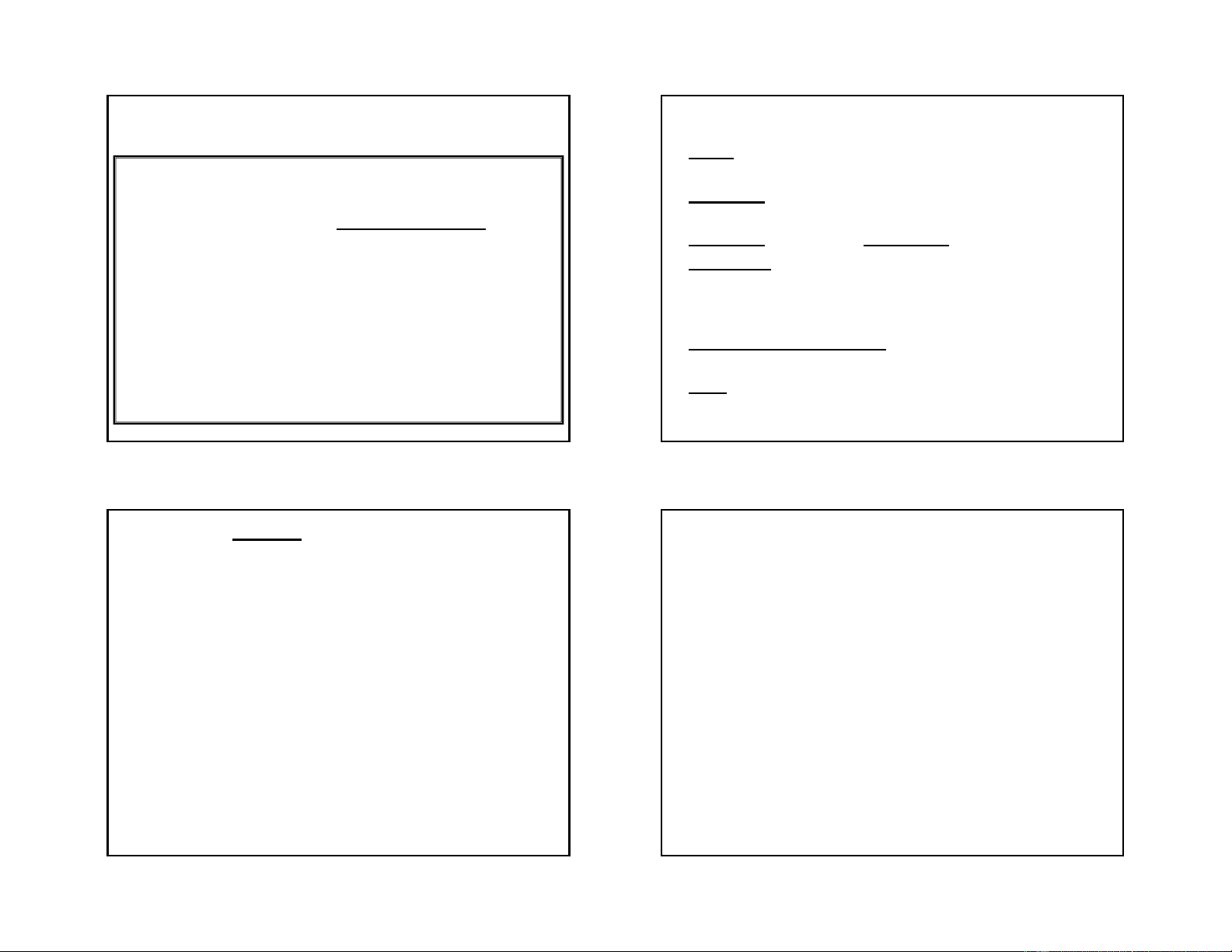
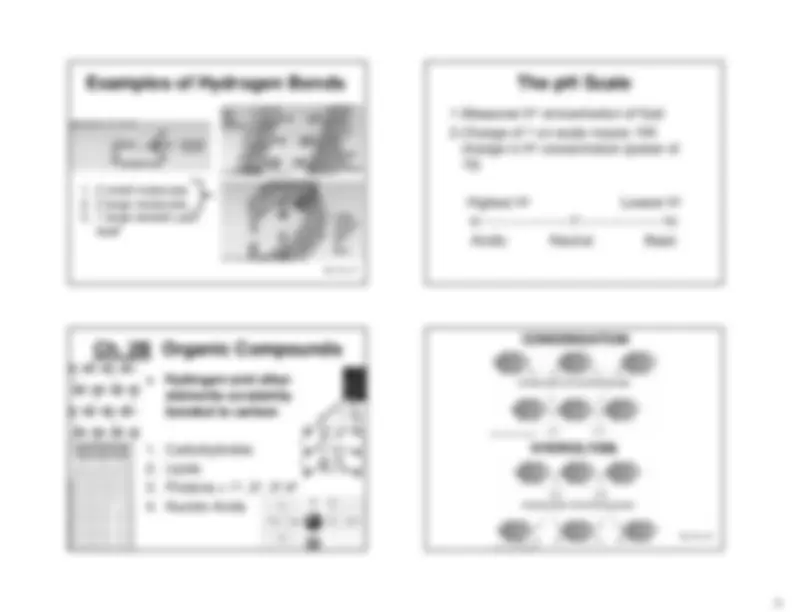
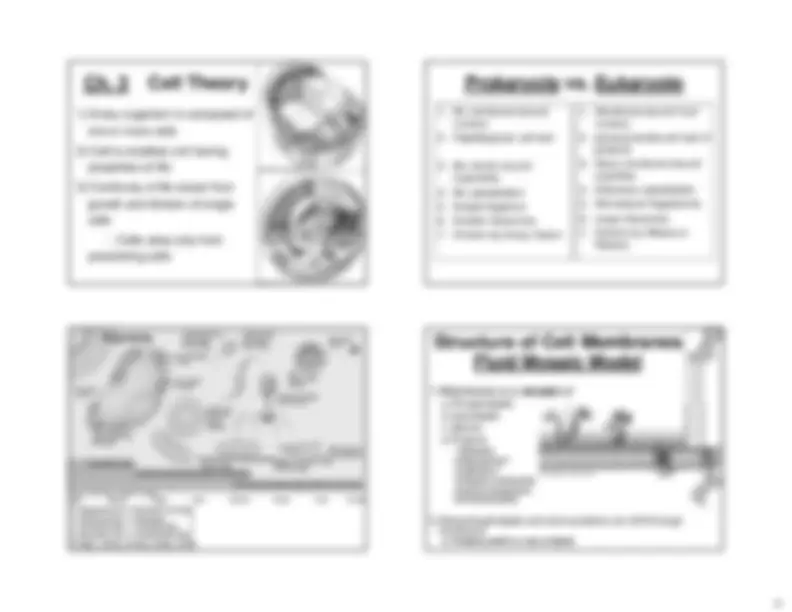
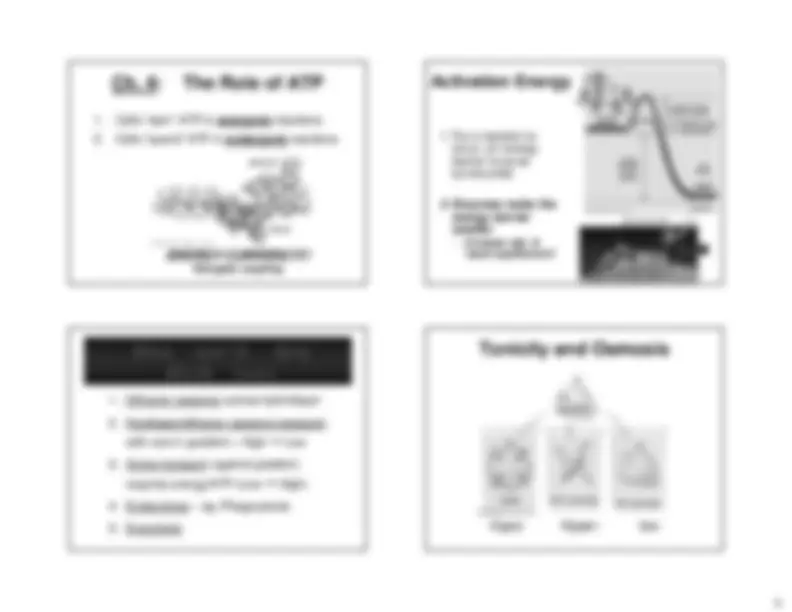
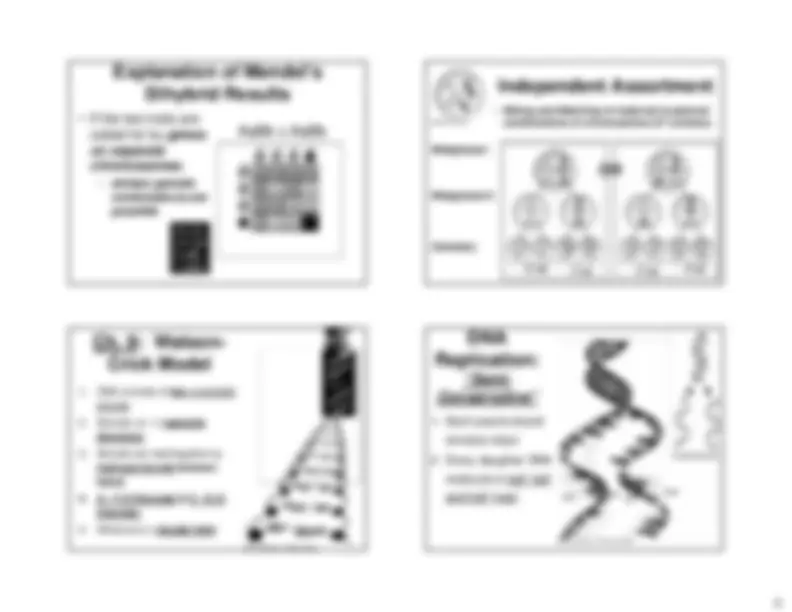
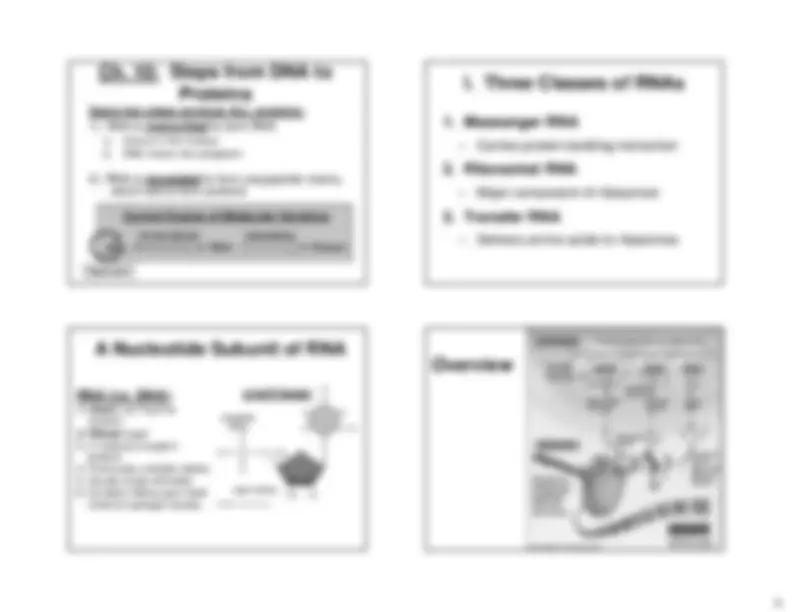
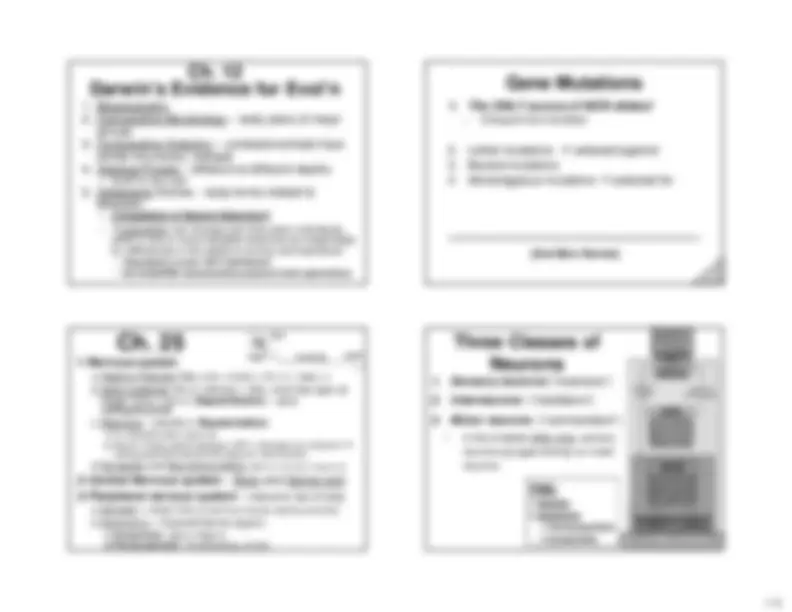


Study with the several resources on Docsity

Earn points by helping other students or get them with a premium plan


Prepare for your exams
Study with the several resources on Docsity

Earn points to download
Earn points by helping other students or get them with a premium plan
Community
Ask the community for help and clear up your study doubts
Discover the best universities in your country according to Docsity users
Free resources
Download our free guides on studying techniques, anxiety management strategies, and thesis advice from Docsity tutors
An outline for a biology exam, including the format (multiple choice questions and essays), topics covered (molecules of life, cell structure and function, genetics, and evolution), and study materials (chapters 1-12 from a biology textbook).
Typology: Study notes
1 / 11

This page cannot be seen from the preview
Don't miss anything!







1.1. Everything due this week! Reports! Extra Credit!!Everything due this week! Reports! Extra Credit!! 2.2. Final Monday 5/23, at 11:10amFinal Monday 5/23, at 11:10am--1:40pm1:40pm a. ~45a.~45--50 M/C questions50 M/C questions –– 15 from sections I-15 from sections I-IIIIII b. 30 from last section (viruses, plants, humanb.30 from last section (viruses, plants, human physiology, ecology)physiology, ecology) c. Essays: 1 of 2 cumulative, 2 of 3 Section IV. c.Essays: 1 of 2 cumulative, 2 of 3 Section IV. d. Mostly from past exams, or variations of those questions d.Mostly from past exams, or variations of those questions e. Fewe.Few ““big picturebig picture”” questionsquestions 3.3. Bring regular 100 questionBring regular 100 question scantronscantron & pencil& pencil 4.4. Use review sheets, study hard, and good luck!!Use review sheets, study hard, and good luck!! 5.5. Thanks for a Great Semester!!Thanks for a Great Semester!!
Biol 110: Main Themes Biol110: Main Themes 1.1. UnityUnity^ – biomolecules–biomolecules, properties of cells, properties of cells
a.a. (^) Atoms (protons, neutrons, electrons), moleculesAtoms (protons, neutrons, electrons), molecules b. b. (^) CHNOPSCHNOPS
1.1. Observe phenomenonObserve phenomenon
2.2. Develop hypothesesDevelop hypotheses
3.3.^ Make predictionsMake predictions
4.4.^ Devise test of predictionsDevise test of predictions
5.5. Carry out test and analyze resultsCarry out test and analyze results
Ch. 2A Ch. 2A
Most CommonMost Common
Elements in LifeElements in Life
(CHNOPS)
a.Lowest energya.Lowest energy
b.b.Holds 1 orbital with up to 2Holds 1 orbital with up to 2 electronselectrons
a.4a.4 orbitalsorbitals hold up to 8hold up to 8 electrons (electrons ( OCTET RULEOCTET RULE ))
CALCIUM 20p+ , 20e-
1.1. No membrane-No membrane-boundbound nucleusnucleus 2.2. Peptidoglycan cell wallPeptidoglycancell wall
3.3.^ No membNomemb..--boundbound organellesorganelles 4.4. No cytoskeletonNo cytoskeleton 5.5. Simple flagellumSimple flagellum 6.6. Smaller ribosomesSmallerribosomes 7.7.^ Division by binary fissionDivision by binary fission
1.1. MembraneMembrane--boundbound ““truetrue”” nucleusnucleus 2.2. polysaccharide cell wall (ifpolysaccharide cell wall (if present)present) 3.3. Many membraneMany membrane--boundbound orgnellesorgnelles 4.4.^ Extensive cytoskeletonExtensive cytoskeleton 5.5.^ Microtubule flagella/ciliaMicrotubule flagella/cilia 6.6. LargeLarge ribosomesribosomes 7.7. Division by Mitosis orDivision by Mitosis or MeiosisMeiosis
frog egg3 mm
Typical plant cell10-100 μm
mitochondrion1-5 μm
chloroplast2-10 μm
human redblood cell 7-8 μmdiameter
Trypanosoma (protozoan) 25 μm long
Chlamydomonas (green alga) 5-6 μm long
Poliovirus30 nm
HIV(AIDS virus) 100 nm T4 bacteriophage225 nm long
tobacco mosaic virus 300 nm long
DNA molecule2 nm diameter UNAIDED VISION
ELECRON MICROSCOPES (DOWN TO 0.5 NM)
LIGHT MICROSCOPE (DOWN TO 200 NM)
Escherichia coli (bacterium) 1-5 μm long
1 centimeter (cm) = 1/100 meter, or 0.4 inch 1 millimeter (mm) = 1/1,000 meter 1 micrometer (μm) = 1/1,000,000 meter 1 nanometer (nm) = 1/1,000,000,000 meter 1 meter = 10^2 cm = 10^3 mm = 10 6 μm = 10^9 nm
1mm 100 μm 10 μm 1 μm 100 nm 10 nm 1 nm 0.5 nm
OrganellesOrganelles
1.Membrane is a 1.Membrane is a mosaicmosaic ofof a.a. PhospholipidsPhospholipids b.b. GlycolipidsGlycolipids c.c. SterolsSterols d.d. ProteinsProteins 1)1) ReceptorReceptor 2)2) RecognitionRecognition** 3)3) AdhesionAdhesion 4)4) Passive transportersPassive transporters 5)5) Active transportersActive transporters 6)6) CommunicationCommunication**
2.Most phospholipids and some proteins can drift through 2.Most phospholipids and some proteins can drift through membranemembrane a.a. Proteins adrift in a sea of lipidsProteins adrift in a sea of lipids
2.2.^ CellsCells ““spendspend”” ATP inATP in^ endergonicendergonic^ reactionsreactions
P (^) P P
ribose
adenine
Energetic coupling
Activation Energy Activation Energy
activation energywithout enzyme activation energywith enzyme
released^ energy reactionby the
products
substancestarting
ENZYME!
direction of reaction
1.1.^ Diffusion (passive) across lipidDiffusion (passive)across lipid bilayerbilayer
2.2. Facilitated diffusion (passive transport):Facilitated diffusion (passive transport): with concwithconc’’nn gradient = Highgradient = High ÆÆ (^) LowLow
3.3.^ Active transport: against gradient;Active transport: against gradient; requires energy/ATP (Lowrequires energy/ATP (Low ÆÆ High)High)
4.4.^ Endocytosis –Endocytosis– egeg:: PhagocytosisPhagocytosis
5.5.^ ExocytosisExocytosis
2% sucrose
water 10% sucrose (^) 2% sucrose
Homologs separate!! 2n Æ n
Prophase I Prophase I (^) Metaphase IMetaphase I Anaphase IAnaphase I^ TelophaseTelophase II
there is no DNA replicationthere is no DNA replication between the two divisionsbetween the two divisions^ Sister chromatids separate (~mitosis, but^ n^ Æ n )
Prophase IIProphase II (^) Metaphase IIMetaphase II Anaphase IIAnaphase II^ TelophaseTelophase IIII
A pair of homologous chromosomes
A gene locus
A pair of alleles
Three pairs of genes
1.1. GenesGenes 2.2. AllelesAlleles 3.3. HomozygousHomozygous 4.4. HeterozygousHeterozygous 5.5. DiploidDiploid 6.6. HaploidHaploid
7.7. P, F1, F2P, F1, F 8.8. Monohybrid 3:1Monohybrid 3: 9.9. DihybridDihybrid 9:3:3:19:3:3: 10.10. SegregationSegregation 11.11. Independent AssortmentIndependent Assortment
12.12. DominantDominant 13.13. RecessiveRecessive 14.14. GenotypeGenotype 15.15. PhenotypePhenotype
Dominant v. Recessive (hidden)
NO Blending! Æ segregation of traits/alleles
Recessive trait reemerges, 3:1 Phenotypic ratio
aB
AB AB
Ab ab
Ab
aB
ab
1/
1/
1/ 1/
1/4 1/4 1/4 1/
AaBb Aabb aaBbaabb
AABB AABb AaBB AaBb AABb AAbb AaBb Aabb AaBBAaBb aaBB aaBb
1/16 1/16 1/16 1/ 1/16 1/16 1/16 1/ 1/16 1/16 1/16 1/ 1/16 1/16 (^) 1/16 1/
AaBb x AaBb
9 A_B_ 3 A_bb 3 aaB_ 1 aabb
Metaphase IMetaphase I
Metaphase II:Metaphase II:
Gametes:Gametes:
1/4 1/4 ABAB (^) 1/41/4 abab 1/41/4 AbAb 1/41/4 aBaB
AA AA AA AA
AA AA AA AA
AA AA AA AA
BB BB
BB^ BB
BB BB
BB^ BB BB BB BB BB
aa aa aa aa
aa aa aa aa
aa aa aa aa
bb bb bbbb
bb^ bb bb^ bb bb bb bb bb
OR OR
strandsstrands
2.2. Strands run inStrands run in oppositeopposite
directionsdirections
hydrogen bondshydrogen bonds betweenbetween basesbases
4.4. AA -- T (2 HT (2 H--bonds)bonds) && CC -- G (3G (
HH--bonds)bonds)
“Semi “Semi-- ConservativeConservative””
new old^ new old
1.1. BiogeographyBiogeography 2.2. Comparative MorphologyComparative Morphology –– body plans of majorbody plans of major groupsgroups 3.3. Comparative AnatomyComparative Anatomy –– unrelated animals haveunrelated animals have similar structures; vestigialsimilar structures; vestigial 4.4. Geology/FossilsGeology/Fossils –– different at different depthsdifferent at different depths
1.1.^ The ONLY source of NEW alleles!The ONLY source of NEW alleles!
2.2. Lethal mutationsLethal mutations ÆÆ selected againstselected against 3.3. Neutral mutationsNeutral mutations 4.4.^ Advantageous mutationsAdvantageous mutations^ ÆÆ^ selected forselected for
[End Main Review][End Main Review]**
Ch. 25Ch. 25
1.1. Nervous systemNervous system a.a. Resting PotentialResting Potential (Na+ out = more +, K+ in = less +)(Na+ out = more +, K+ in = less +) b.b. Action potentialAction potential (All or nothing!) = Na+ channels open at(All or nothing!) = Na+ channels open at trigger zone, rush in (trigger zone, rush in ( DepolarizationDepolarization )) –– all orall or nothing/thresholdnothing/threshold c.c. RecoveryRecovery: (results in: (results in RepolarizationRepolarization ))
2.2. Central Nervous systemCentral Nervous system^ – – BrainBrain andand Spinal cordSpinal cord
3.3. Peripheral nervous systemPeripheral nervous system – – extend to rest of bodyextend to rest of body a.a. SomaticSomatic = motor= motor fxnsfxns^ (to and from muscle, tendons and skin)(to and from muscle, tendons and skin) b.b. AutonomicAutonomic = Visceral/internal organs;= Visceral/internal organs; 1) Sympathetic 1)Sympathetic (fight or flight) &(fight or flight) & 2) Parasympathetic 2)Parasympathetic (^) (housekeeping, at rest)(housekeeping, at rest)
input
trigger conducting output
1. 1. Sensory neuronsSensory neurons (“(“receiversreceivers””)) 2. 2. InterneuronsInterneurons (^) ((““mediatorsmediators””)) 3. 3. Motor neuronsMotor neurons ((““commanderscommanders””)) - • In the simplestIn the simplest reflex arcsreflex arcs, sensory, sensory neurons synapse directly on motorneurons synapse directly on motor neuronsneurons
PNS: 1.Somatic 2.Autonomic 1.Parasympathetic 2.Sympathetic
CENTRAL NERVOUS SYSTEM brain spinal cord sensorynerves axons of motor nerves
subdivisionsomatic These nerves carry(motor functions) signals to and fromskeletal muscles, tendons, and skin.
subdivisionautonomic (visceral functions)These nerves carry internal organs (gut,signals to and from heart, glands, etc.). parasympatheticnerves sympatheticnerves
PERIPHERAL NERVOUS SYSTEM
action potential resting potential resting potential
resting potential restored action potential resting potential
K + Na+
Na+
unsheathed node axon
“Jellyrolled” Schwann cells of an axon’s myelin sheath
Fig. 30.11, p. 494
nodes
Saltatory Conduction
Ch. 23Ch. 23 1.1. (^) Nonspecific ImmunityNonspecific Immunity a.a. BarriersBarriers b.b. ComplementComplement c.c. InflammationInflammation
2. 2. Specific ImmunitySpecific Immunity – memory cells,–memory cells, effectoreffector cellscells a.a.^ AntibodyAntibody--mediated Immunitymediated Immunity^ – – B cells, MHC/APC,B cells, MHC/APC, helper Thelper T [[extracellularextracellular pathogens]pathogens] b.b.^ CellCell--mediated Immunitymediated Immunity –– APC, helper T,APC, helper T, TcTc, NK, NK [intracellular pathogens][intracellular pathogens]
3.3. (^) When Immunity goes wrong or failsWhen Immunity goes wrong or fails a.a. Autoimmune diseaseAutoimmune disease –– MS, rheumatoid arthritisMS, rheumatoid arthritis b.b. AllergiesAllergies –– IgEIgE, Mast Cells, Histamine, Mast Cells, Histamine c.c. ImmunodeficienciesImmunodeficiencies –– egeg: AIDS: AIDS
1. 1. (^) MHC markersMHC markers (^) == ““tagstags”” that sound thethat sound the ““alarmalarm”” 2. 2. (^) AntigenAntigen--presenting cells (presenting cells (APCsAPCs)) = “=“scoutsscouts”” a.a. B cellsB cells b.b. DendriticDendritic cellscells c.c. MacrophagesMacrophages d.d.^ …….many other cells of the body.many other cells of the body…….. 3. 3. (^) Helper T cells (Helper T cells (ThTh)) = “=“buglersbuglers”” rally the troops!rally the troops! 4. 4. (^) EffectorEffector cytoxiccytoxic T cells (T cells (TcTc)) (^) == ““skilledskilled swordsmenswordsmen”” 5. 5. (^) Natural killer cells (NK)Natural killer cells (NK) (^) == ““frontline swordsmenfrontline swordsmen”” 6. 6. B cellsB cells = “=“archers andarchers and taggerstaggers””
Naive helper T cell
Naive B cell
Antigen- presenting cell
ActivatedActivated helper T cellhelper T cell
Effector B cellEffectorB cell (plasma cell)(plasma cell)
Naive cytotoxic T cell
EffectorEffector cytotoxiccytotoxic T cellT cell
Antibody - mediated response Cell - mediated response
(APC)
interleukinsinterleukins (^) interleukinsinterleukins